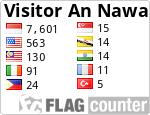Hegemoni Khulafa’ Al-Rasyidin Dalam Penerapan Kebijakan Taqlil Al-Riwayah
Abstract
This article examines Khulafa’ al-Rasyidin's policy of imposing restrictions on the transmission of hadith which began to develop at that time. The implementation of the taqlil al-riwayah policy is quite different and seems to conflict with the time of the prophet. During the time of the Prophet, the companions were asked to spread the words of the Prophet to people who did not know them, but during the time of the Khulafa’ al-Rasyidin they adopted a policy of limiting (al-tathabut fi riwayah) and reducing transmission (taqlil al -riwayah). So ultimately the policies taken are contrary to what the prophet ordered. In this research, the method used is qualitative-descriptive through library research. The results of this study show that the implementation of the taqlil al-riwayah khulafa' al-rasyidin policy had a major influence on the development of hadith after the Prophet's death. As a religious leader, the caliph of course takes care of matters relating to religious affairs as well as the hadiths of the prophet. The taqlil al-riwayah policy is a form of caution in transmitting hadith from irresponsible people. The caliphs' caution in narrating hadith from the prophet was simply fear and worry of making mistakes in the hadith either being tainted by lies or alterations.
References
Abu Hatim, M. bin H. (1996). Al-Sirah al-Nabawiyah wa Akhbar al-Khulafa’. Beirut: al-Kutub al-Thaqafiyah.
Ahmadin. (2020). Sejarah Peradaban Islam. Jakarta: Kencana.
al-Bukhari, M. bin I. (2011). Al-Jami’ al-Musnad al-Sahih al-Mukhtasar min Umur Rasulillah wa Sunanihi wa Ayamihi. Beirut: Dar al-Tauq al-Najah.
al-Imrani, M. bin ’Ali. (2001). Al-Inba’ fi Tarikh al-Khulafa’. Mesir: Dar al-Afak al-Arabiyah.
al-Khatib, M. ’Ajjaj. (1980). Al-Sunnah Qabla al-Tadwin. Beirut: Dar al-Fikr.
al-Naisaburiy, M. bin al-Hajaj. (2010). Al-Musnad al-Sahih al-Mukhtasar bi Naqli al-’Adli ila Rasulullilah. Beirut: Dar Ihya’.
al-Suyuthi, J. (2004). Tarikh al-Khulafa’. Mekkah: Maktabah Nazar.
al-Dzahabi. (2009). Tadzkirah al-Huffadh. Beirut: Dar Kutub al-’Ilmiyah.
Amin, A., Safri, E., & Hakim, L. (2020). Hadis Dan Politik: Kebijakan Taqlīl al-Riwāyah pada Masa Abu Bakar al-Shiddiq dan Umar Bin al-Khaṭṭāb. Mashdar: Jurnal Studi Al-Qur’an Dan Hadis, 2(1), 77–106. https://doi.org/10.15548/mashdar.v2i1.1283
Andariati, L. (2020). Hadis dan Sejarah Perkembangannya. Diroyah : Jurnal Studi Ilmu Hadis, 4(2), 153–166. https://doi.org/10.15575/diroyah.v4i2.4680
Bakri, S. (2011). Peta Sejarah Peradaban Islam. Yogyakarta: Fajar Media Press.
Fathoni, H. (2020). Kodifikasi Hadis Dalam Pandangan Sunniy Dan Shi’iy. Nabawi: Journal of Hadith Studies, 1(1). https://doi.org/10.55987/njhs.v1i1.10
Hanbal, A. bin M. (2001). Musnad al-Imam Ahmad bin Hanbal. Beirut: Muassasah al-Risalah.
Idri. (2013). Studi Hadis. Jakarta: Kencana.
Kanus, O. (2022). Pembatasan dalam Periwayatan Hadis (Taqlil ar-Riwayah). Jurnal Kawakib, 3(1), 1–10. https://doi.org/10.24036/kwkib.v3i1.34
Moleong, L. J. (2018). Metode Peneletian Kualitatif. Bandung: Remaja Rosdakarya.
Mu’awanah, A. (2019). Perkembangan Hadis pada Masa Sahabat: (Taqlil wa Tathabbut min al-Riwayah). KACA (Karunia Cahaya Allah): Jurnal Dialogis Ilmu Ushuluddin, 9(2), 126–147. https://doi.org/10.36781/kaca.v9i2.3037
Nazim, A. M. (2019). Manhaj al-Khulafa’urrasyidin fi Idarah ad-daulah al-Islamiyah. Jakarta: Pustaka Al-Kautsar.
Tuqus, M. S. (2003). Tarikh al-Khulafa’ al-Rasyidin al-Futuhat. Lebanon: Dar al-Nafaas.
Zainudin, E. (2015). Peradaban Islam Pada Masa Khulafaur Rasyidun. Intelegensia : Jurnal Pendidikan Islam, 3(1). https://doi.org/10.34001/intelegensia.v3i1.1337













